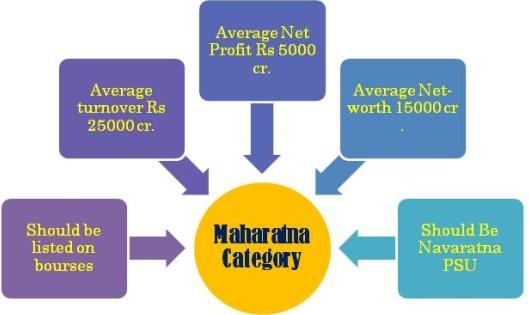List of Maharatna, Navratna and Miniratna PSUs
The Public Sector Enterprises are run by the Government under the Department of Public Enterprises of Ministry of Heavy Industries and Public Enterprises. The government grants the status of Navratna, Miniratna and Maharatna to Central Public Sector Enterprises (CPSEs) based upon the profit made by these CPSEs.
The Maharatna category has been the most recent one since 2009, the other two have been in function since 1997.
In our country, a Public Sector Undertaking (PSU) is a government-owned corporation. These companies are owned and operated by the Union Government of India, or a state government, or both. This company’s equity is majorly owned by the government, hence the named PSU. The need for setting up of PSUs arises because industrial development of any country requires a strong foundation supported by reliable infrastructure. And infrastructure development is fundamentally a capital-intensive industry, which may not be lucrative for the private sector. Therefore, Government runs the Public Sector Enterprises.
After economic reforms, various PSUs have been awarded additional financial autonomy by the Government. These corporations are “public sector companies that have comparative advantages”. Which means that the Government has given them greater autonomy in their functioning to compete in the global market in order to support these enterprises in becoming global giants(players).
Currently, this level of financial autonomy is divided into the following three categories:
- Maharatna
- Navratna
- Miniratna Category -I and II
The criteria for giving Maharatna Status:
- The company already holds Navratna status.
- It is listed on the Indian stock exchange fulfilling the minimum prescribed public shareholding according to the SEBI regulations.

- The Average annual turnover of company during the last 3 years is more than Rs. 25,000 crore.
- The Average annual net worth during the last 3 years is more than Rs. 15,000 crore.
- The Average annual net profit after tax during the last 3 years is more than Rs. 5,000 crore.
- The company should have a significant global presence or international operations.
There are 8 Maharatna CPSEs, namely:
- Bharat Heavy Electricals Limited
- Coal India Limited
- GAIL (India) Limited
- Indian Oil Corporation Limited
- NTPC Limited
- Oil & Natural Gas Corporation Limited
- Steel Authority of India Limited
- Bharat Petroleum Corporation Limited (moved from Navratna to Maharatna)
Criteria for giving Navratna Status :
- The company must have ‘Miniratna Category – I‘ status along with a Schedule ‘A’ listing.
- It should have at least 3 ‘Excellent’ or ‘Very Good’ Memorandum of Understanding (MoU) during the last five years.
- Along with the above, it should also have a composite score of 60 or above out of possible 100 marks in the 6 selected performance parameters:-
- Net Profit to Net Worth (Maximum: 25)
- Manpower cost to cost of production or services (Maximum: 15)
- Gross margin as capital employed (Maximum: 15)
- Gross profit as Turnover (Maximum: 15)
- Earnings per Share (Maximum: 10)
- Inter-Sectoral comparison based on Net profit to net worth (Maximum: 20)
There are 16 Navratna CPSEs in the country, these are:
- Bharat Electronics Limited
- Container Corporation of India Limited
- Engineers India Limited
- Hindustan Aeronautics Limited
- Hindustan Petroleum Corporation Limited
- Mahanagar Telephone Nigam Limited
- National Aluminium Company Limited
- National Buildings Construction Corporation Limited
- NMDC Limited
- Neyveli Lignite Corporation Limited
- Oil India Limited
- Power Finance Corporation Limited
- Power Grid Corporation of India Limited
- Rashtriya Ispat Nigam Limited
- Rural Electrification Corporation Limited
- Shipping Corporation of India Limited
Criteria for giving Miniratna Status:
Those CPSEs that have shown profits in the last continuous three years and have positive net worth, can be considered eligible for grant of Miniratna status. Presently, there are 75 Miniratnas in total. Generally, questions are not asked of these companies owing to their sheer number. But noteworthy is their categorisation. The Miniratnas are divided in two categories – I and II.
Category I: These have made profits for the last three years continuously or earned a net profit of Rs. 30 crores or more in one of these three years. There are 60 such companies.
Category II : These companies have made profits continuously for the last three years and must have a positive net worth. There are 15 such companies in this category.
<< Read about Kisan Vikas Patra here >>
In various examinations, the questions are asked based upon the number of Maharatna, Navratna and Miniratna companies in India. In exams conducted by these PSUs for recruitment, thee are also questions asked based on general awareness about the criteria considered for granting these three financial autonomy status to companies. Such questions are answerable by reading the above compilation.
<< Click here to read about Chola Empire and their architecture >>
<< Read about Physiology of India for quick revision click here>>
If you want us to make any changes or additions to the above information, please mention that in the comments section below. Keep visiting for more study material relevant for examinations. You can bookmark this site by pressing (Ctrl +D).





